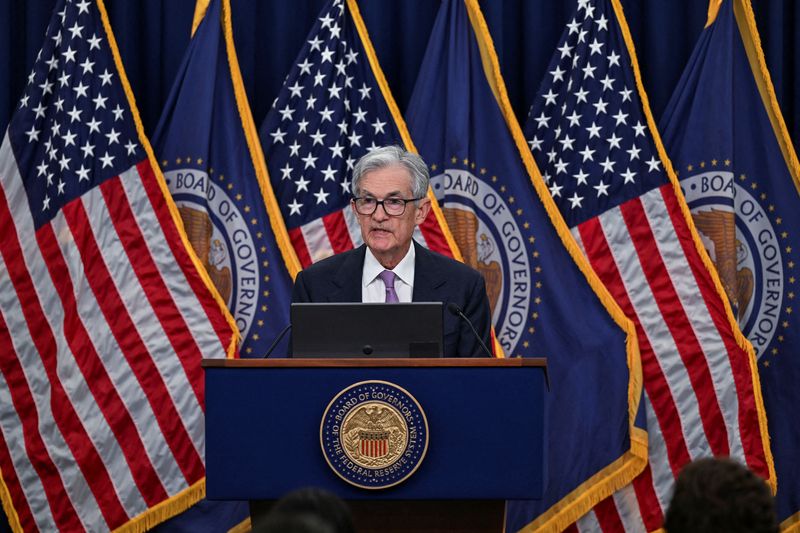A look at the day ahead in U.S. and global markets from Mike Dolan
Even with another Federal Reserve interest rate cut this week baked in to market pricing, U.S. Treasury bonds appear anxious again about the year ahead - with political upheavals in Germany and Canada clouding the overseas picture.
As the Fed meets for the last time this year, there's little doubt in futures markets that it will cut another quarter point off its policy rate.
But with the sort of roaring growth in the dominant U.S. services sector seen in this week's December surveys, record high stock markets and likely tax cuts ahead, barely two more cuts are expected next year and Fed policymakers are expected to lift their estimate of long-run neutral rates above 3%.
U.S. November retail and industrial updates should add grist to the Fed mill on the first of its two-day meeting on Tuesday.
The combination of the growth, rates and fiscal picture going into 2025 has seen 10-year Treasury yields complete a round trip 30 basis points in a month - recapturing 4.4% this week to its highest since Nov. 21 and up 30 basis points from the lows of Dec. 6.
The 30-year "long bond" yield has done likewise, a poor backdrop to the 20-year debt sale later on Tuesday.
Worryingly, the New York Fed's estimate of the so-called term premium demanded by investors for holding long-term Treasury paper is rearing up again too, with the 10-year gauge back at 28 bps for the first time in more than a month - suggesting fiscal worries as much as stubborn Fed fears.
Even though it spurred Bitcoin to new highs of $107,821 on Monday, jitters about sound fiscal management won't have been eased much by President-elect Donald Trump reiterating bizarre plans to create a bitcoin strategic reserve similar to its strategic oil reserve to help pay off the national debt.
Overseas political angst also created some disquiet about the fiscal picture in the wider G7.
The Canadian dollar and Canadian government debt yields rose as the abrupt resignation of Canada's finance minister Chrystia Freeland leaves the government adrift less a month before Trump takes office with promised tariff hikes.
Potentially undermining Prime Minister Justin Trudeau's government ahead of next October's elections, Freeland quit on Monday after Trudeau offered her a lesser position. She said his wish to increase spending could endanger Canada's ability to withstand the damage done by Trump's tariffs.
In Europe, Germany looks set to head to the polls in February after Chancellor Olaf Scholz lost a confidence vote on Monday - a move he designed to trigger the poll after the collapse last month of his ruling coalition government.
With the latest IFO German business surveys showing another worrying drop in sentiment there this month, the euro and German bund yields slipped.
France, meantime, remains in something of a political hiatus despite the appointment of veteran centrist Francois Bayrou as France's new prime minister, with ratings firm Moody's (NYSE:MCO) joining other agencies in cutting France's rating by one notch late last week over the state of government finances.
The dollar index was higher on Tuesday generally.
Dollar/yen pulled back a touch from Monday's three-week high, but dollar/yuan continues to probe higher.
Economists polled by Reuters now see no Bank of Japan interest rate rise at its meeting this week - a big shift in opinion in just a few weeks.
The yuan remains under pressure, however, after another spate of week economic numbers - and expectations of aggressive policy easing that may follow.
China's capital markets outflow reached a record high of $45.7 billion in November, according to official data tracking cross-border payments, as the prospect of a Trump return to the White House jarred. Some signs of potential detente between the two countries were evident this week, however.
Initially disappointed by the lack of detail in the latest Chinese government policy meeting last week, Chinese stocks then bounced back on Tuesday after Reuters reported the country would retain its 5% economic growth target for next year with a historically high budget deficit of 4% of GDP.
Elsewhere, sterling was higher after sparky UK wage growth data put paid to any remote thoughts the Bank of England might cut interest rates this week - and suggested a relatively hawkish stance may persist there.
After the latest highs, Wall Street stock futures were marginally lower ahead of the bell.
Key developments that should provide more direction to U.S. markets later on Tuesday:
* US November retail sales, industrial production, December NAHB housing index, December New York Federal Reserve service sector survey, October business inventories; Canada November CPI inflation

* Federal Reserve's Federal Open Market Committee begins two-day policy meeting, decision Wednesday
* U.S. Treasury sells $13 billion of 20-year bonds
(By Mike Dolan,; mike.dolan@thomsonreuters.com; Editing by Tomasz Janowski)